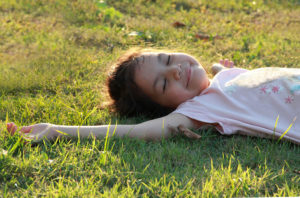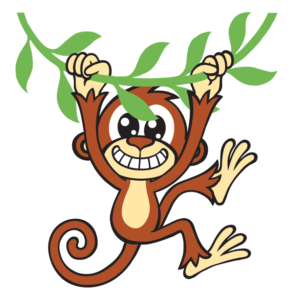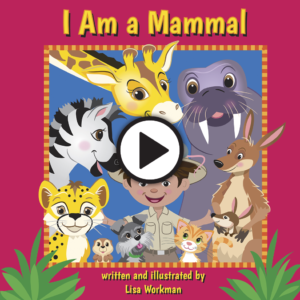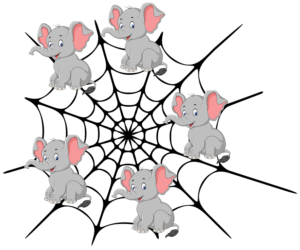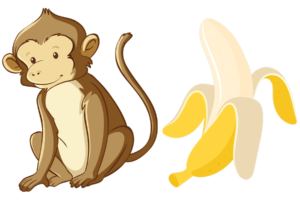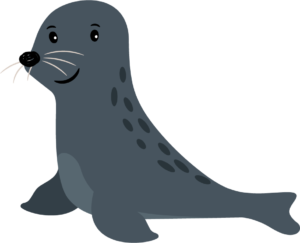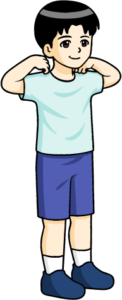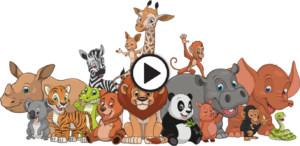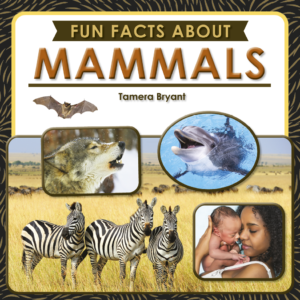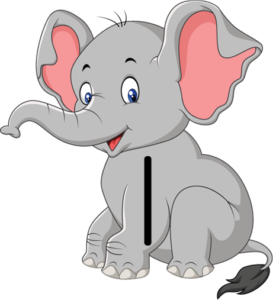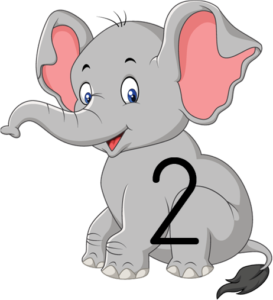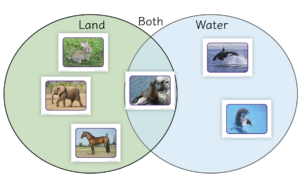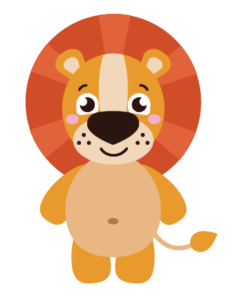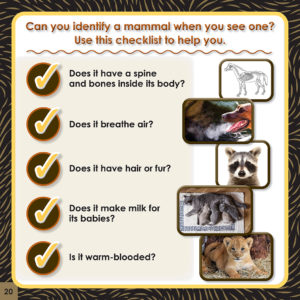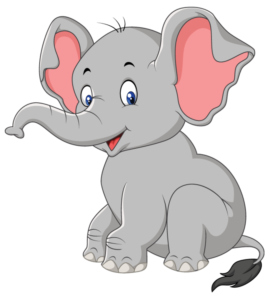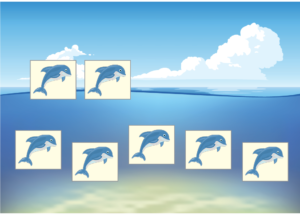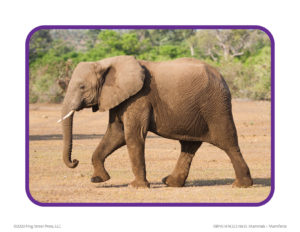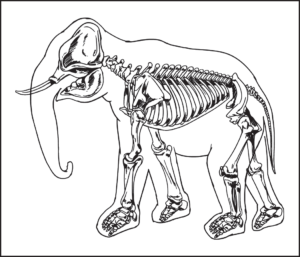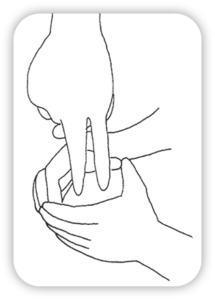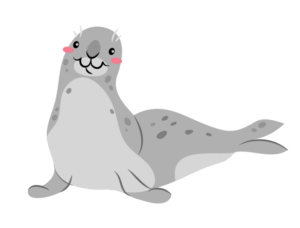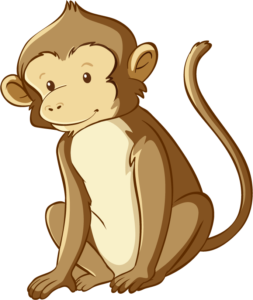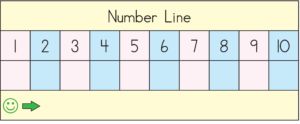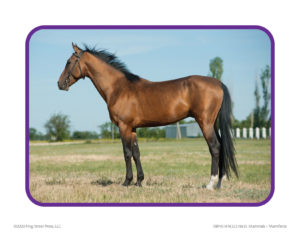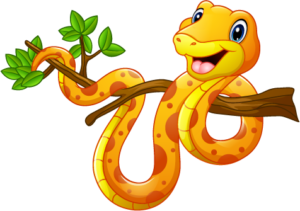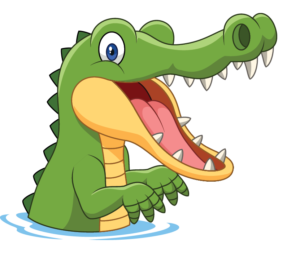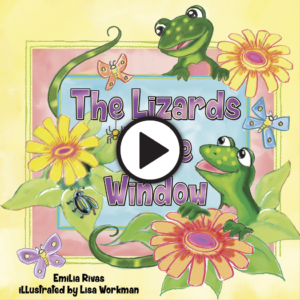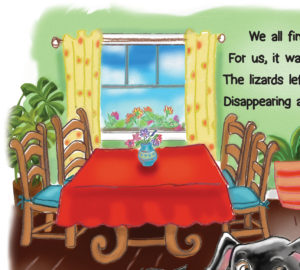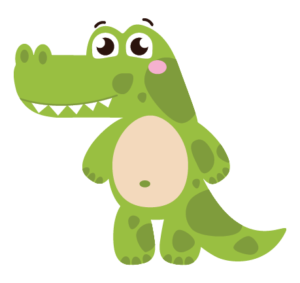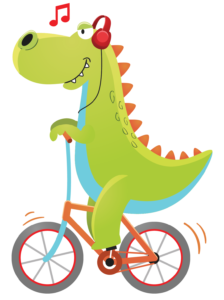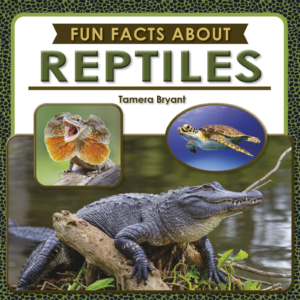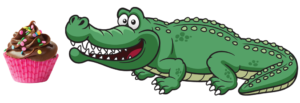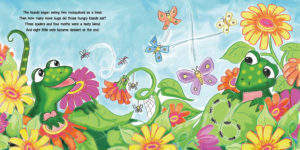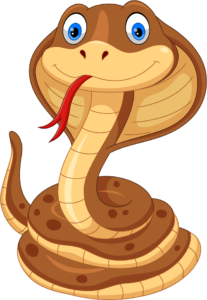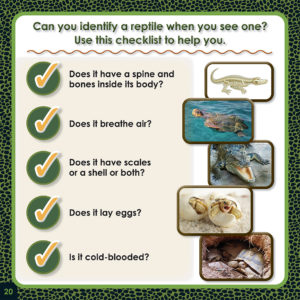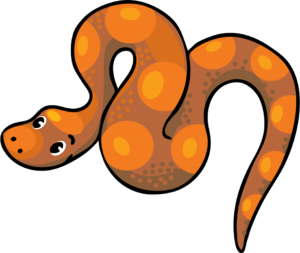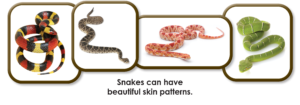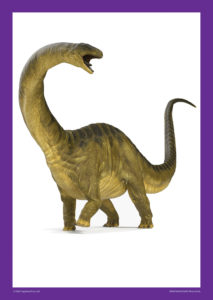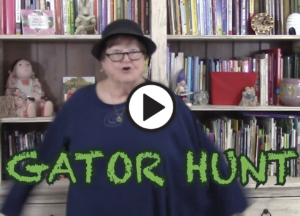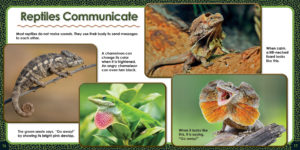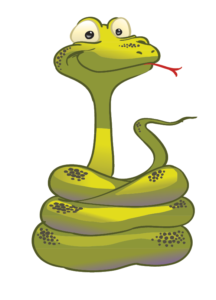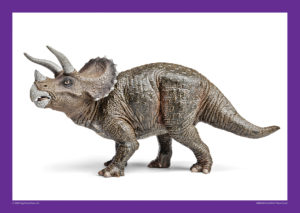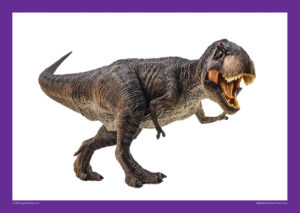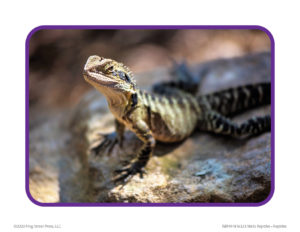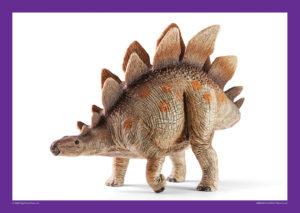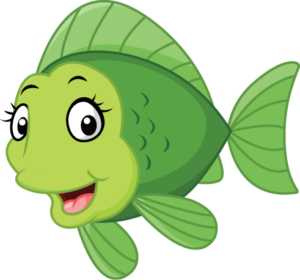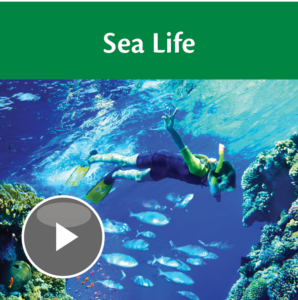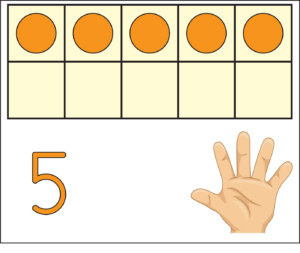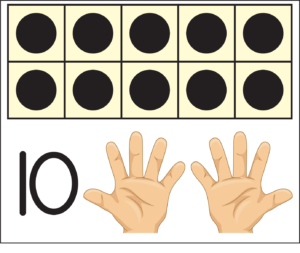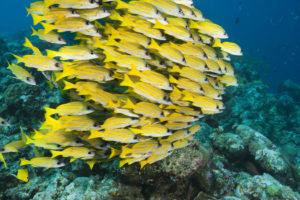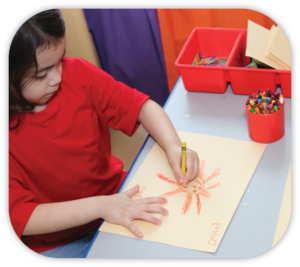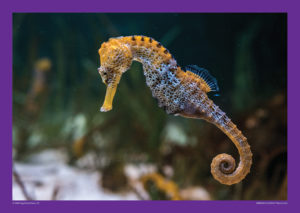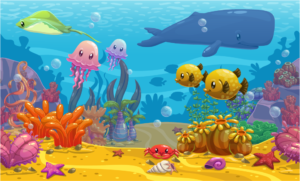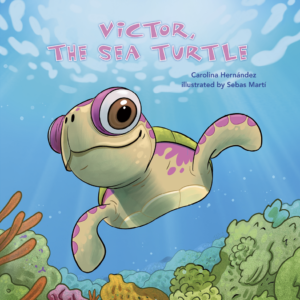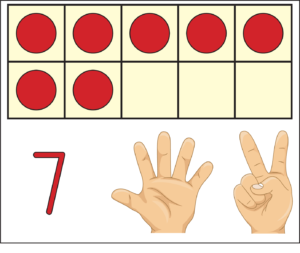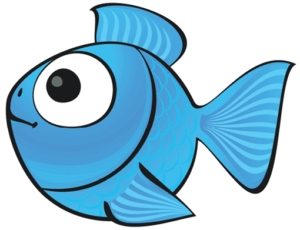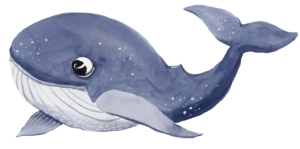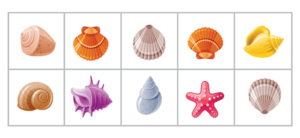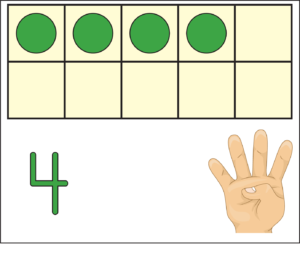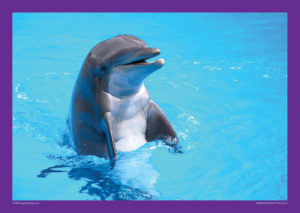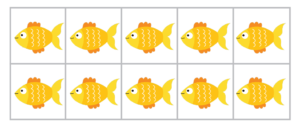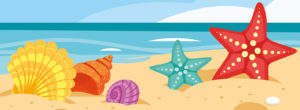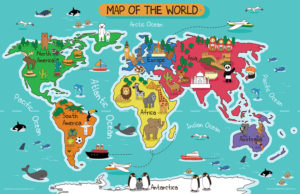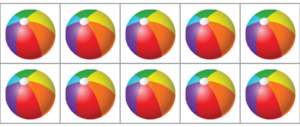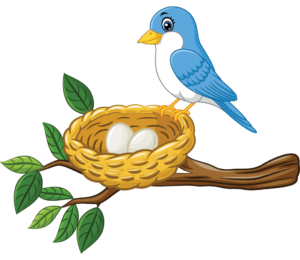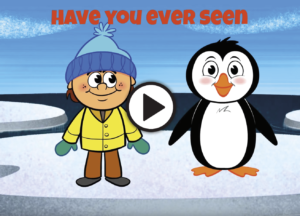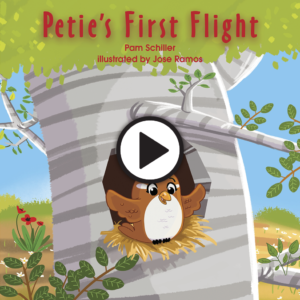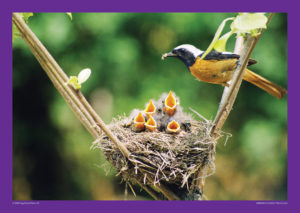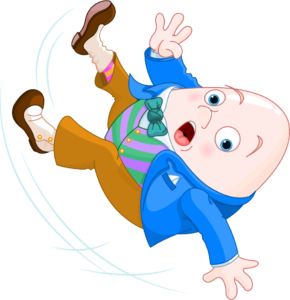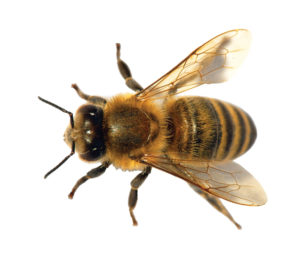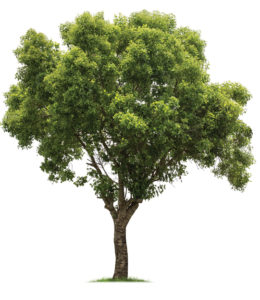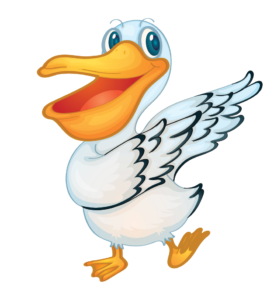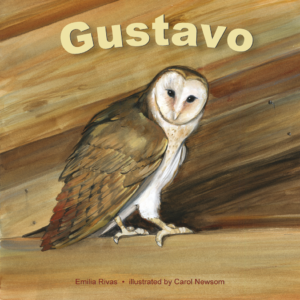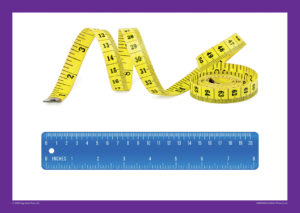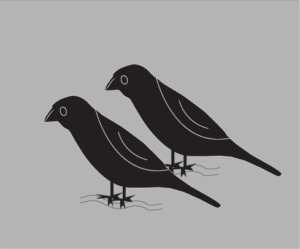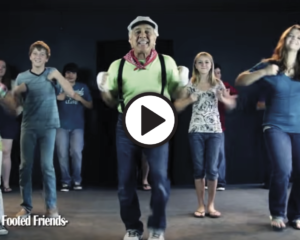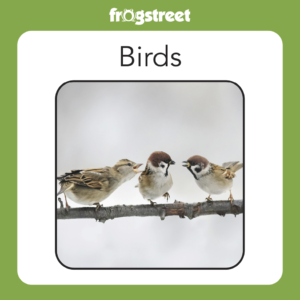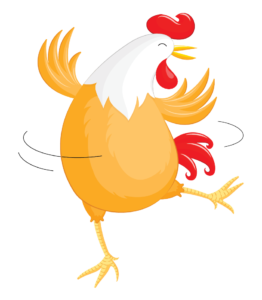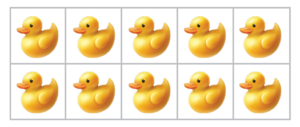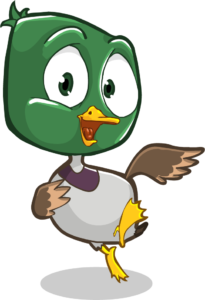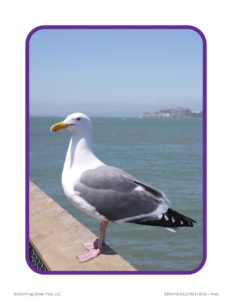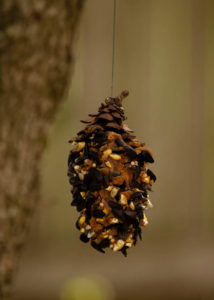Animals
Week 1: Mammals
This week, your child will learn that mammals are a special kind of animal that breathes air, has a backbone (spine), is warm-blooded, and has hair or fur. Mammal mothers feed their babies with milk.
Word of the Week: mammal
Before You Begin
Watch these videos to better understand the concepts your child will be learning this week. These are not videos you will watch with your child. These are just for you!

Books to Read
- Fun Facts About Mammals eBook
- I Am a Mammal Read-Aloud video
Supplies to Gather
- animal book
- cotton balls
- index cards
- jar
- journal
- making butter: jar, cream (one pint), salt, bread
- mirror
- paper
- paper bag
- paper clips
- paper cups
- paper cut in shape of bear or dog
- pennies
- small blocks
- stackable items (plastic glasses, cans or boxes of food, plastic cereal bowls)
- writing tools
Daily Message
A mammal is an animal with fur or hair.
- Say the sentence. Ask your child to repeat it. Count the words.
- Write the sentence one word at a time as your child recalls each word.
- Write h, l, n, u under the sentence. Have your child use a marker to circle these letters in the sentence.
Storytime
Watch the read-aloud video I Am a Mammal with your child. This isan informational book, but it is written in rhyme. Ask: How is this book different from many of the information books we have read? (no photos, make-believe characters, rhyming text, no Table of Contents or Index)
One Elephant
Sing “One Elephant” with your child. Encourage her to use one hand as the spider’s web and the fingers on the opposite hand to show how many elephants are jumping on the web. Ask: How many elephants would there be if another elephant joined the five? Have your child use markers, paper and paper clips to show the answer. Click image for lyrics.
Are You a Mammal?
Have your child look in a mirror for characteristics of a mammal. Have him look for hair on his arms and head. Have him find and feel his backbone (spine). Have him exhale onto the mirror. Ask: Why did the mirror get foggy? Explain that the warmth of his breath causes condensation, which are small droplets of water. Say: You are breathing!
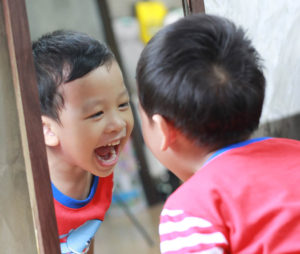
Read About Animals
Choose a book about animals from your home or your neighborhood library. Look at the photos or pictures and talk about the animals. Ask: Is this animal a mammal? How do you know? If your child is interested in a particular animal, read the text about that animal to learn some new facts.
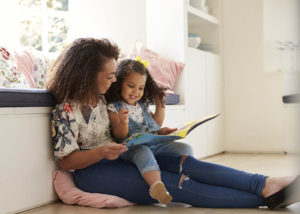
Daily Message
Do you have a backbone and hair?
- Say the sentence. Ask your child to repeat it. Count the words.
- Write the sentence one word at a time as your child recalls each word.
- Write the sentence a second time using a lowercase letter at the beginning and no punctuation at the end.
- Have your child correct errors in the second sentence.
Count the Words
Say a sentence tapping your shoulders for each word. Have your child repeat. Say the sentence again slowly and ask: How many words? Have your child draw a line for each word on paper (short lines for short words, long lines for longer words). Ask: Do we have the same number of lines as words? Click image for sentences.
Storytime
Fun Facts About Mammals is full of interesting facts about many kinds of mammals. Look at the photos in the book as you move through the pages. Name the mammals and talk about them from your experience. When you reach the end, ask: What did you learn by looking at the photos of mammals? (Tomorrow you will read the book.)
One-More Pattern
Click image #1 to sing “One Elephant.” Ask: How does the number of elephants change each time you sing the verse? (one more elephant joined). Have your child make stacks of blocks or same-size squares of paper to match the “one-more” pattern of the growing number of elephants on the spider web. Click image #2 for elephant pattern.
Milking Cows
Tell your child a number story: A farmer wants to milk five cows. He has milked three cows. How many cows does he still need to milk? Have your child count five paper cups. Move three cups to the side (milked cows). The two other cups are the cows that have not been milked. Have your child use paper and markers to draw and retell the number story.
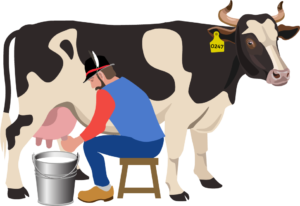
In Our House
Ask: What mammals do we have living in our house? Mammals have hair, they breathe, they make their own heat (feel warm), and they have a spine. People, cats, dogs, and hamsters are mammals. Talk with your child about a pet or a neighbor’s pet . Call attention to its mammal characteristics.
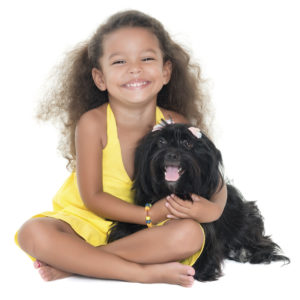
Daily Message
An anteater scoops up ants with its long tongue.
- Say the sentence. Ask your child to repeat it. Count the words.
- Write the sentence one word at a time as your child recalls each word.
- Write h, l, n, u below the sentence. Have your child name each letter and say its sound.
- Have your child use a marker to circle these letters in the sentence.
Writing Together
Remind your child that when you were learning about insects, you made a list of the characteristics that all insects have. Today, make a list of the characteristics that mammals have. Work together to make the list. You will use your checklist during the week. Click image to see checklist from Fun Facts about Mammals to help you.
Storytime
Read Fun Facts about Mammals to learn more about this group of animals. After reading, have your child tell about some of the facts he found interesting. Ask: What new facts did you learn? What mammal would you like to learn more about?
Five Silly Monkeys
Sing “Five Silly Monkeys.” Have your child use cotton balls to show the number of monkeys in each verse. After singing, discuss the one-less pattern. Ask: How many monkeys started out in the tree? What happens next? Does the number get smaller or bigger? Do you notice a pattern in the way the number of monkeys gets smaller? (one less each time) Click image for lyrics.
Sleeping Schedules
Click here to reread pages 10-11 of Fun Facts About Mammals. Talk about the number of hours koalas, sloths, and horses sleep each day. Count out 24 pennies onto a sheet of paper divided in two columns to represent the number of hours in one day (24 hours). Place the pennies in the columns to show how many hours an animal is awake and asleep.
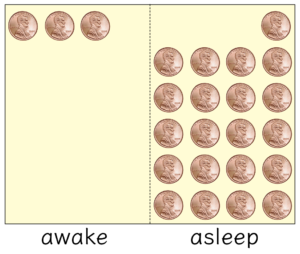
Here’s the Bunny
Have your child use a hand with two fingers extended as ears (bunny) to jump into a hole (form circle with your hands). Then, have your child be a big bunny with arms extended and use his entire body to jump in the hole (form a large circle with two arms). When the bunny jumps in the hole, give a little squeeze (a bunny hug!). Click image for verse.
Daily Message
Horses can sleep standing up!
- Say the sentence. Ask your child to repeat it. Count the words.
- Write the sentence one word at a time as your child recalls each word. Read the sentence together with excitement.
- Write H, l, n, u under the sentence. Have your child say each letter’s name and sound. Have your child circle these letters in the sentence.
My Journal
Look at the Mammal Checklist you and your child created yesterday. Track the words with your hand as you “read” the words together. Have your child draw a mammal on the first blank page of her journal. Have her label the mammal’s characteristics on the drawing. Help as needed.
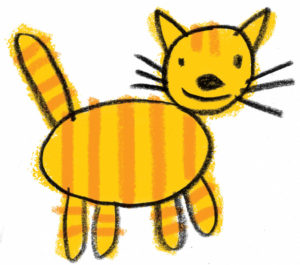
Silly Seal Slide
Watch the “Silly Seal Slide” video to see how seals move. Have your child lie on the floor and push up with her hands. Your child’s hands and arms will be the seal’s flippers. As your child drags herself along, ask: How does it feel to move like a seal? Do you think it would be easier for a seal to move on land or in the water? Click image for lyrics.
Storytime
Watch the read-aloud video I Am a Mammal. Ask: What is your favorite land mammal? What is your favorite sea mammal? What information in the book did you find surprising? Use the mammal checklist you created yesterday to confirm that your child’s favorites are mammals.
One-Less Pattern
Sing “Five Silly Monkeys.” Ask: How does the number of monkeys change each time you sing the verse? (one less monkey swinging). Have your child make stacks of blocks or same-size squares of paper to show the “one-less” pattern that matches the shrinking number of monkeys on the vine. Click image for monkey pattern.
Elephant Parade
Tell your child a number story about elephants in a parade. Say: Four elephants are waiting in a line to start a parade. Three elephants join them. Ask: How many elephants are now waiting in the line? Invite your child to use paper clips or small blocks to show how many elephants there are altogether (7). Have your child use paper and markers to draw the story.
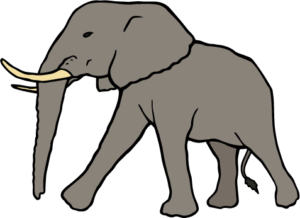
Making Butter
Pour one pint of room temperature cream into a jar with a tight lid. Explain that cream comes from cow’s milk. Take turns with your child shaking the jar. Explain that the harder he shakes the jar, the sooner the cream will turn to butter. When the cream thickens into butter, add a pinch of salt and serve on bread.
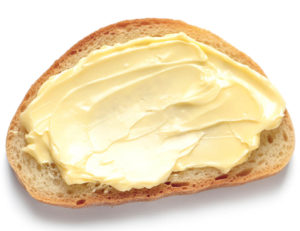
One Less
Use items in your kitchen to create a one-less pattern. Find a group of stackable objects (plastic glasses, cans or boxes of food, plastic cereal bowls). Have your child build a stack of four. Build stacks of three, two, and one. Challenge your child to arrange the stacks from most to least.

Be Specific
Your child should be able to choose a commitment and show success in keeping it throughout the day. If your child is having trouble, have her be specific about when in your daily routine she will practice the commitment. For example, I will use helping hands during clean up time. The more specific the commitment is, the more successful your child will be.
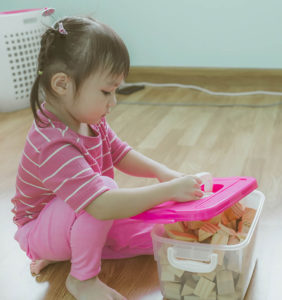
Daily Message
Cheetahs and giraffes run very fast.
- Say the sentence. Ask your child to repeat it. Count the words.
- Write the sentence one word at a time as your child recalls each word. Read the sentence together.
- Write h, n, u under the sentence. Have your child say each letter’s name and sound. Have your child circle these letters in the sentence.
Match Letters
Focus Letters:
Hh, Ll, Nn, Uu
Write the focus letters on index cards (one letter on each card). Mix up the cards. Have your child match each uppercase letter with the correct lowercase letter. Then have your child say the name and sound of each letter. Choose one of the cards and use it to look for matching letters around your home.

Animals at the Zoo
Watch the music video “Move to the Zanzibar Zoo” to get some ideas about how to imitate animal movements. Then listen to the song and try moving like all of the zoo animals. Click image for lyrics.
Storytime
Read pages 10-11 in Fun Facts about Mammals. Introduce the word nocturnal. Some mammals, such as bats, foxes, raccoons, and rodents are nocturnal. This means they sleep during the day and are active at night. Other animals, such as giraffes, horses, and elephants sleep during the night and are active during the day. Ask: Would you rather be active during the day or night? Why?
Before and After
Write a different numeral 1-9 on small squares of paper. Fold the squares and put them in a paper bag. Shake the bag. Remove one numeral at a time. Ask: What numeral is this? Which numeral comes before that numeral on the number line? Which numeral comes after? Repeat for each numeral in the bag. Click image for number line.
See and Do
Play a game called “Monkey See, Monkey Do.” You will be your child’s partner. One person will make a face or movement, and the other will copy it. After a few minutes, switch roles. Explain that monkeys often try to copy what they see others doing.
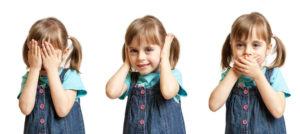
Make It Appear
Cut out the shape of a bear or a dog. Place the cutout under a piece of paper. Have your child rub a crayon over the paper until the outline of the animal appears. Try different animal shapes. Have your child tell a few facts about the animal that appears.
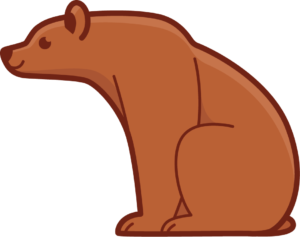
Animals
Week 2: Reptiles
This week, you and your child will learn about the characteristics of reptiles. Reptiles are cold-blooded, hatch their babies from eggs, and have scales or a hard shell.
Word of the Week: reptile
Before You Begin
Watch these videos to better understand the concepts your child will be learning this week. These are not videos you will watch with your child. These are just for you!

Books to Read
- Fun Facts about Reptiles eBook
- Lizards Like to Eat eBook
- Sara Sidney’s First Day of School eBook
- The Lizards in the Window Read-Aloud video
Supplies to Gather
- clay or play dough
- index cards
- journal
- masking tape
- paper
- pennies
- rope
- small blocks or rocks (Spanish)
- small crackers or grapes, blocks or Legos®
- stick-on notes
- writing tools
Slither and Stop
Begin your day with a variation of Walk and Stop. Have fun watching your child change the movements. Say: Today you will move like different reptiles. Ask: How would a snake slither? How do you think a land turtle would move differently than a sea turtle? Sing or chant the lyrics as your child moves and stops like a reptile. Click image for chant.
Daily Message
A snake and a turtle are reptiles. Reptiles are living things.
- Say the sentences. Ask your child to repeat them.
- Write each sentence. Read the sentences together.
- Say tur-tle pausing between syllables. Have your child blend the syllables to say the word. Repeat with rep-tiles.
- Write k, d, and p below the sentences. Have your child find the letters in the sentences.
Deep in the Jungle
Enjoy this musical story “Deep in the Jungle” about a crocodile and three little monkeys. Before you listen, have your child predict what might happen in the song.There is a long introduction before the verses begin. Have your child imagine he is deep in the jungle. Click image for lyrics.
Storytime
Watch the read-aloud video Lizards in the Window. Ask: What did you learn about the food pink-bellied lizards eat? How did the lizards catch the mosquitoes? Which foods do you eat with your tongue?
Windowpanes
Click image to see the windowpane on page 16 of The Lizards in the Window. Point out how the window has three same-size panes on top and one long rectangular pane at the bottom. Panes are plates of glass outlined by a frame. Have your child check the shape and number of panes in several windows of your house.
Snake Walk
Place two 10-foot strips of masking tape in parallel lines 20 inches apart on the floor. Place a rope between the two lines in a curvy shape to represent a crawling snake. Challenge your child to walk or hop from one end of the path (staying between the two tape lines) to the other end without stepping on the “snake.” Try other movements (jumping, tiptoeing).
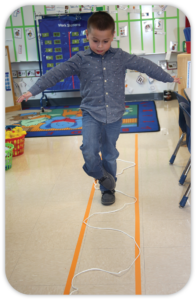
In the Garden
Take your child out to a flowerbed or garden to look for a lizard. Think about where lizards might hide and where you could spot them. If you spot one, your child may be able to see its scales and spine. Count all that you find.
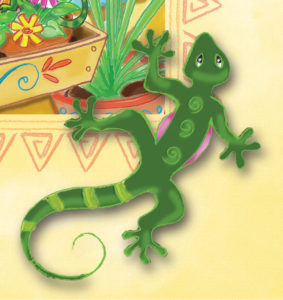
Come Along
Last week you and your child chanted the verse “Oh, Will You Come Along with Me?” naming different mammals. Today you will chant the same song focusing on chameleons, lizards, snakes, and turtles. All of these animals are reptiles. Ask: Which reptile friend would you like to meet? Why? Click image for verse.
Daily Message
Scales or a shell cover the body of a reptile.
- Say the sentence. Ask your child to repeat it.
- Write the sentence. Read the sentence together.
- Say rep-tiles pausing between syllables. Have your child blend the syllables to say the word. Repeat with cov-er.
- Write b, d, and p below the sentences. Have your child find the letters in the sentences.
Practice Blending
Practice blending syllables to form words. Hold out your right hand and say: liz. Hold out your left hand and say: ard. Slide your hands next to each other and say lizard. Have your child say the syllables and word with you. Repeat for more two-syllable words:
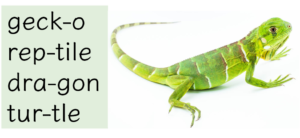
Dinosaurs at School
The song “Please Don’t Bring a Tyrannosaurus Rex to Show-and-Tell” is a silly song about a dinosaur at school. After you listen to the song, ask: Do you agree that dinosaurs belong at home and they don’t do well at school? What other song does this remind you of? (“Mary Had a Little Lamb”) Click image for lyrics.
Storytime
Remind your child about the mammal fact book you read last week. This week you will read Fun Facts about Reptiles to learn about these animals. As you read the book, talk about the photos. Point out that there are many kinds of reptiles. Ask: What is one way all reptiles are alike? What reptiles have you seen?
Ten-Frame Window
Give your child 10 paper squares or stick-on notes. Give clues for how to arrange the squares to look like a ten-frame. Say: The window should be a rectangle. It should have two rows of windowpanes. There should be the same number of square panes in each row. Invite your child to build the window. Ask: How many panes will there be in each row?
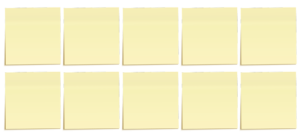
Clay Turtles
Sit with your child to create a pair of turtles. As you shape the clay or play dough, talk about different characteristics. I am making a hard shell. It covers the turtle’s body. The head will stick out of the front. How many legs should I make? Does a turtle have a tail? Compare the turtles when they are complete. Which turtle is larger?
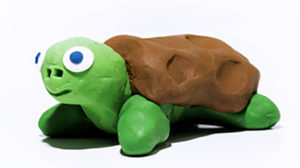
Daily Message
A mammal is warm blooded. A reptile is cold blooded.
- Say the sentences. Ask your child to repeat them.
- Write each sentence. Read the sentences together.
- Say mam-mal pausing between syllables. Have your child blend the syllables to say the word. Repeat with rep-tile.
- Write b, d, and p below the sentences. Have your child find the letters in the sentences.
Boa Constrictor
The boa constrictor is a nighttime hunter that eats rats, birds, monkeys, and wild pigs. Teach your child this echo chant. Point to each body part. Have your child echo each line after you say it. Remind your child that this is a silly chant. Boa constrictors do not eat people. Click image for chant.
Storytime
As you read Fun Facts about Reptiles, focus on the page headings. The headings tell what the pages are about (the topic). Read a heading, such as “Many Kinds of Reptiles”on page 6. Have your child remember some of the facts. Ask: Which reptile is your favorite? Why?
Divide It in Half
Practice dividing a set of familiar objects in half with your child. You might do this with small crackers, grapes, or blocks. Give your child a set of six, eight, or ten objects. Have your child divide the set in half. Dividing in half means to divide equally into two groups. If needed, show your child the “one for you and one for me” method.
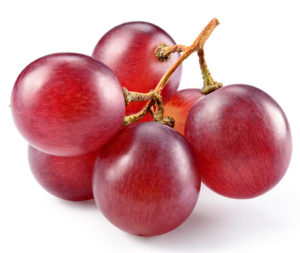
What Am I Drawing?
Tell your child that you are imagining that her back is a sheet of paper and your finger is a marker. Say: I am going to draw a reptile. For example, give a clue such as: This reptile moves very slowly. Then draw the shape of a turtle on your child’s back. Have your child guess what you drew. Take turns drawing and guessing.
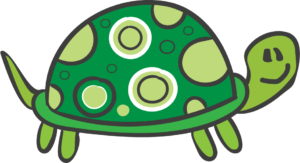
Daily Message
The Komodo dragon is the largest lizard. It could eat a buffalo!
- Say the sentences. Ask your child to repeat them.
- Write the sentences. Read the sentences together.
- Say Ko-mo-do pausing between syllables. Have your child blend the syllables to say the word. Repeat with buf-fa-lo.
- Write K, b, and d below the sentences. Have your child find the letters in the sentences.
My Journal
Show Lizards Like to Eat. Read each page. Encourage your child to read with you. Have her name the pictures and words she knows. Ask: What do you like to eat for dinner? Have your child draw her answer on the first blank page of her journal. If your child is ready, suggest she copy and complete the sentence: I like to eat __________ .
Storytime
Watch the read-aloud video Lizards in the Window. Share a few interesting facts about lizards:
- Lizards use their tongues to smell. They flick their tongues in and out. Have your child flick her tongue.
- Some lizards use their twitching tail to protect themselves. The predator goes after the tail. The lizard’s tail separates from the body and the lizard grows a new tail.
One More
Show 10 pennies. Ask your child to count out a set of 5. Tell him to count the pennies to be sure there are 5. Add one more penny to your child’s set. Ask: How many now? Watch to see if your child counts the pennies or just knows that one more is 6. Continue to add one penny to the growing total until your child sees the “one-more” pattern.
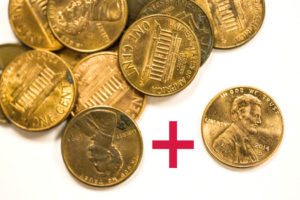
Warm Surfaces
Search outdoors for warm spots (rock beds, brick walls and fences, cement, smooth rocks by a pond) where reptiles might like to sun. Talk about the importance of sunlight to cold-blooded animals. Have your child touch the surface of the warm area and compare it to a shady spot.
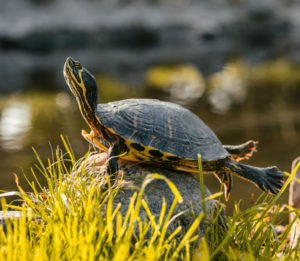
Notice Helpfulness
Look for opportunities during the day to notice your child’s helpful choices. Comment on what your child does and explain that it was helpful. For example: You held the door open so that we could walk through safely. That was helpful.

Daily Message
Snakes sleep with their eyes open! Alligators take long naps.
- Say the sentences. Ask your child to repeat them.
- Write each sentence. Read the sentences together.
- Say al-li-ga-tors pausing between syllables. Have your child blend the syllables to say the word. Repeat with o-pen.
- Write k and p below the sentences. Have your child find the letters in the sentences.
Match Letters
Focus Letters: Bb, Dd, Kk, Pp
Write the focus letters on index cards. Have your child match the correct uppercase letter to each lowercase letter. (Point out the straight and curved lines on p, b, and d. The lowercase p has a straight line that points down. Lowercase b and d have a straight line that points up.) Have your child choose a card and say the letter’s name and sound.

Storytime
Read Fun Facts about Reptiles. Say: Dinosaurs were reptiles. What are some ways that the reptiles in the book look like dinosaurs? Share some fun facts about these prehistoric reptiles. Click dinosaur images for models and facts.
One Less
Show 10 pennies. Ask your child to count out a set of 6. Have him count the pennies again to be sure there are 6. Remove one penny from your child’s set. Ask: How many now? Watch to see if your child counts the pennies or just knows that one less is 5. Continue to remove one penny from the set until your child sees the “one-less” pattern.
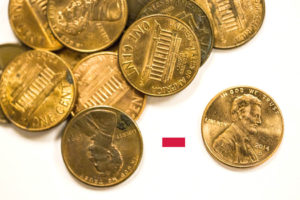
Animals
Week 3: Sea Life
This week, your child will explore sea life. Your child will learn about creatures big and small that live in the ocean.
Word of the Week: marine
Before You Begin
Watch these videos to better understand the concepts your child will be learning this week. These are not videos you will watch with your child. These are just for you!

Books to Read
- Poems and Rhymes eBook
- Sea Life Video eBook
- Victor, the Sea Turtle eBook
Supplies to Gather
- 0-5 dot cards (index cards, sticky dots or markers)
- 100-foot length of rope or yarn
- blue watercolor paint
- familiar book
- fishing pole: string, yardstick, wide package tape, small items (paper fish, pebbles, leaves, jar lids)
- jar or plastic container
- journal
- nature’s paintbrushes: grass, plant clippings, leaves, dandelion heads, watercolors
- paper
- plastic rings for a six-pack of soda
- small blocks
- small objects (like seashells)
- writing tools
Five Little Fishes
Explain that “rocking to the beat” means dancing or moving with the rhythm. This add-on poem says that fish splish and splash as they rock with the beat. Ask: What kind of fish do you imagine the song is about? Recite the verse or sing it to the familiar tune of “Over in the Meadow.” Click image for poem.
Daily Message
Sea turtles and dolphins live in the ocean.
- Say the sentence.
- Say the word tur-tles pausing between syllables. Ask your child to blend the syllables and say the word. Repeat with dol-phins.
- Write the sentence. Have your child “read” the words with you.
- Write a y for v in live. Say: I think I made a mistake! Have your child correct the mistake.
Silly Seal Slide
Watch the music video “The Silly Seal Slide.” Enjoy watching some real seals move both in land and water. Ask: Why is it easier for seals to move in water? Do you feel more comfortable moving in water or on land? Try out the seal moves as you sing along with the song. Click image for lyrics.
Storytime
Watch the Sea Life Video eBook. After the video, talk about the marine animals. Have your child name some marine animals and plants that he learned about. Write your child’s ideas on a list. Add to this list throughout the week as you continue to learn about marine life.
School of Fish
Small fish swim together in a large group called a school. Swimming in a school keeps smaller fish safe. When small fish that look alike swim together in a group, they look bigger to larger fish that might want to eat them. Swimming together also makes finding food easier. Click image to learn more.
Fishing Pole
Attach string to the end of a stick to make a fishing pole. Tie a loop of sticky package tape to the bottom of the string to be a sticky “hook.” Have your child “fish” with the pole to see which small items (paper fish, pebbles, leaves, jar lids) will or will not stick to the tape.
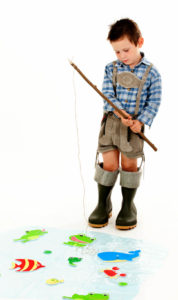
Do a Favorite
Have your child lead your family in a calming strategy. Have her choose: Drain, Balloon, Bunny Breathing, Pretzel or S.T.A.R. Remind your child to breathe in through the nose and exhale slowly through the mouth three times.
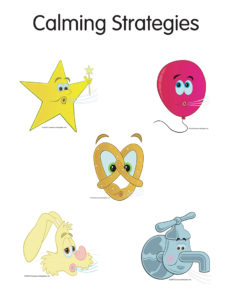
Daily Message
Tiny plants and sea creatures live in a reef.
- Say the sentence.
- Say the word ti-ny pausing between syllables. Ask your child to blend the syllables and say the word. Repeat for crea-tures.
- Write the sentence. Have your child “read” the words with you.
- Write a lowercase letter at the beginning of the sentence. Say: I think I made a mistake! Have your child correct the mistake.
The Last Syllable
Say the beginning part of a word and have your child give the end (final syllable). Begin by having your child name the marine animals in the photos. Then say the first part of an animal’s name and ask your child to complete the word with the final syllable. Click image to get started!
Storytime
The characters in today’s story are marine animals. Read Victor the Sea Turtle with your child. Turn to pages 4-5. Ask: How is Victor feeling? How can you tell? The illustrator, Sebas Martí, shows Victor’s feelings. Say: Illustrations help to tell a story.
Count Beyond 10
Invite your child to count to 10 on her fingers. Once she reaches 10, challenge her to think about how to count beyond 10 without having more fingers to use. Ask: What comes after 10? How could you show 11 with your fingers? Model how to count beyond 10 by starting the counting process over (11-20) on the same set of hands.
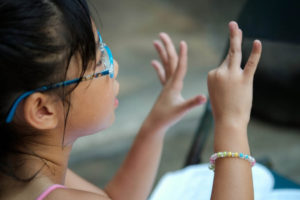
Nature’s Paintbrushes
Help your child gather bundles of grass, plant clippings, leaves, or dandelions to use as paintbrushes. Have your child paint with water on the side of a building or use watercolors on butcher paper. Your child can also make a leaf print by painting the surface of a leaf and then pressing it onto paper.
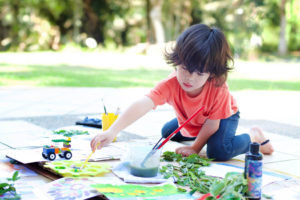
Letter Hunt
One of the skills your child is learning is to recognize and match uppercase and lowercase letters. Look at a page of a familiar book. Have your child point to and name one letter on the page. Then see if the two of you can locate more examples of the letter. Have your child tell whether each example you find is uppercase or lowercase.
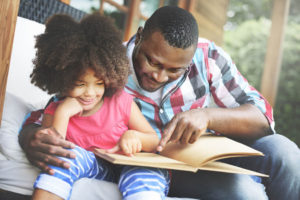
Count and Catch
Act out a familiar counting rhyme. Have your child hold one hand up with fingers spread out. Touch each finger while counting to five and then gently grab your child’s hand as if catching a fish. Count the fingers on your child’s other hand (from six to ten). Look surprised and let the “fish” go. Give your child a chance to count and catch. Click image for rhyme.
Daily Message
Some sea animals live in water and on land.
- Say the sentence.
- Say the word an-i-mals pausing between syllables. Ask your child to blend the syllables and say the word. Repeat for wa-ter.
- Write the sentence. Have your child “read” the words with you.
- Do not put a period at the end of the sentence. Say: I think I made a mistake! Have your child correct your mistake.
Writing Together
Work with your child to write a list of at least five marine animals. Then together think of words that describe each of the animals. For example, after writing “octopus” on your list add a describing word before it, such as “flexible octopus.” Have your child read the list with you.
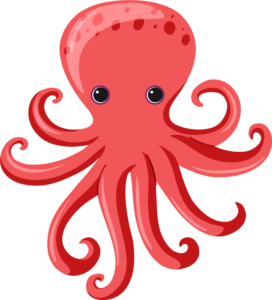
Storytime
Read Victor the Sea Turtle with your child. In this book, Victor learns a lesson. When a story teaches a lesson, we sometimes call the lesson a moral. Ask: What do you think Victor learned? How is that lesson important to you?
Plastic Hazards
Explain to your child that when plastic gets into the ocean, it is a hazard to the fish and birds that live there. They can mistake the plastic for food or get tangled in it. Find a discarded plastic six-pack ring from sodas. Have your child help you cut the rings into little pieces to prevent sea animals from getting tangled in them.
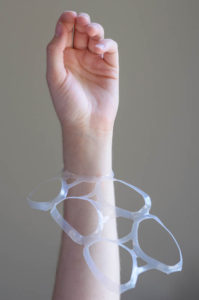
Paint the Ocean
Have your child draw marine life with crayons on drawing paper. Your child may choose to draw many different small fish or a single giant sea creature like a whale. Help your child brush blue watercolor paint over the drawing. The blue paint is the water. Crayons are made of wax and paint will not stick to the wax. The animals will be in a blue sea.
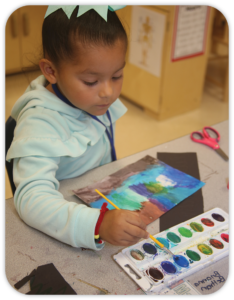
Ocean Resources
Talk with your child about the many things (resources) that the ocean gives us. For example, the ocean is a home for fish, crabs, shrimp, and other foods we eat. Farmers and gardeners use ocean sand. Artists use seashells for jewelry. Children jump in the waves. Ask: What things can you think of that come from the ocean?
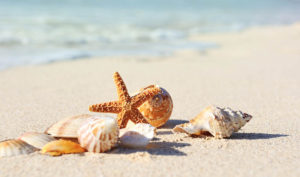
Daily Message
Our job is to take care of the ocean. We can recycle plastic bottles.
- Say the sentences.
- Say the word re-cy-cle pausing between syllables. Ask your child to blend the syllables and say the word. Repeat for plas-tic.
- Write the sentences. Have your child “read” the words with you.
- Write the letter M for W in the word “We.” Say: I think I made a mistake! Have your child correct the mistake.
My Journal
Ask your child to choose a favorite marine animal and draw it on the first blank page in her journal. Suggest that she write the name of the animal under the drawing. Assist as needed. Click image for some marine animal choices. Your child may choose one of these animals or a different animal.
Storytime
Watch the Sea Life Video eBook with your child. Read the names of some of the animals on your Marine Life list. Have your child use hand movements to show the size of the animals (arms wide for big animals, hands about a foot apart for medium-sized, and hands two inches apart for small). Add a few new animals to your list.
Estimate How Many
Put seven small objects (such as seashells) inside a jar. Explain: Estimating is not counting. It means looking closely at a set and making a good guess about how many there might be. Ask: How many do you think are inside the jar? Remove five from the jar. Ask: How many are still inside? Five outside, two inside. How many altogether? Was your estimate a good one?
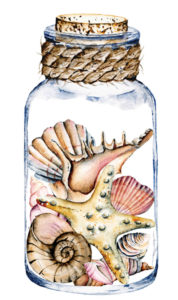
Big as a Blue Whale
Remind your child that the blue whale is the largest marine animal. Explain that it can be 100 feet long. Go outdoors and lay a 100-foot length of rope or yarn on the ground to show your child the size of this majestic animal. Invite your child to walk that distance.
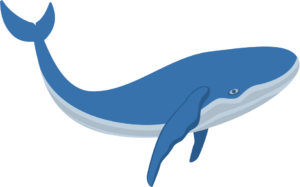
Make Minutes Count
Practice counting to 20 with your child:
- Count together as you walk.
- Take turns counting (you say “1,” your child says “2”) in the car.
- Count down from 20 to 0 as you wait in the grocery line.
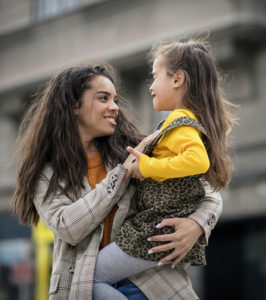
Ocean Conservation
Conservation is the careful protection of something. Talk about what you and your child can do to protect the plants and animals that live in the ocean. For example, plastic in the ocean is a hazard to fish and birds. They can mistake plastic for food or get tangled in it. Clean up after visiting the ocean so no trash ends up in the water.

Daily Message
The ocean is full of treasures. What do you like about the ocean?
- Say the sentences.
- Say the word trea-sures pausing between syllables. Ask your child to blend the syllables and say the word. Repeat for o-cean.
- Write the sentences. Have your child “read” the words with you.
- Have your child answer the question.
Alike and Different
Focus Letters: Ww, Vv, Cc, Mm, Nn, Ss, Yy, Oo
Write the lowercase y and v on paper. Have your child name the letters and tell how they are alike and different. Repeat with these letter pairs: W-V, c-o, m-n, c-s, v-w. If your child confuses other letters consistently, compare the two confusing letters. Point out similarities and differences.

Storytime
Watch the Sea Life Video eBook. Help your child understand that there is more ocean than land in our world. Click image to see a world map.
Fingers and Toes
Have your child rote count from 1 to 20. (Rote counting is a memory task. It is saying the counting words in order.) When your child is able to repeat the sequence of numbers, help him picture the quantity of 20. Have your child count to 10 on his fingers and then switch to his toes for 11 to 20.
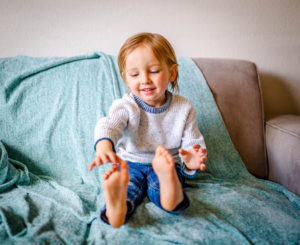
Marine Life
Talk about differences between reptiles and mammals. Mammals: backbone, hair or fur, babies that drink milk, warm blooded, breathe air. Reptiles: cold-blooded, babies hatch from eggs, scales and/or shell. Say: Marine animals can be mammals or reptiles. Click image to name marine animals as mammals or reptiles.
Underwater Outing
Visit an aquarium or go to a local pet store to see the fish, turtles, and snails. Notice the many different kinds of plants and animals. If you can’t get to either of these locations, you might choose to watch some videos on YouTube. Talk with your child about how marine animals are different from land animals.
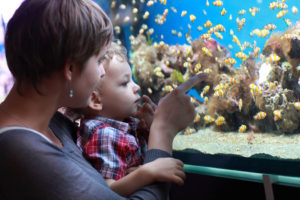
Animals
Week 4: Birds
This week, you and your child will learn about birds and their habitats. You will read about feathers, wings, bills, and eggs. Your child will discover that there are many different kinds of birds.
Word of the Week: chick
Before You Begin
Watch this video to better understand the concepts your child will be learning this week. This is not a video you will watch with your child. This is just for you!

Books to Read
- Birds eBook
- Gustavo eBook
- Petie’s First Flight Read-Aloud video
- Petie’s First Flight eBook
Supplies to Gather
- bird feeders: yarn or string, pinecone, peanut butter, birdseed, empty toilet paper tube
- cardboard boxes
- clear plastic containers (5)
- cotton balls (15)
- cup
- different-sized containers
- hard-boiled egg: egg, salt, pot of boiling water
- jar
- journal
- paper
- pennies
- same-sized grocery bags with handles (2)
- same-sized stackable items (empty soda cans, bottles of water)
- sets of 10 same-sized objects (at least two sets)
- small objects (like plastic eggs) 15
- storage case or plastic bag with 9 small objects (markers)
- toilet paper squares
- water
- writing tools
Daily Message
Some birds are brown. Some birds are red.
- Say the sentences. Ask child to repeat them.
- Say: Red rhymes with bed. Both words end with /ed/. Explain that you will say three words and your child will tell you the two words that rhyme. Say: red, bed, tree—Which two words rhyme? Repeat with words: brown, some, down.
- Write the sentences as your child recalls each word.
Penguin Song
Watch “Penguin Song.” This active song adds a movement with each verse. Explain that your child will be a penguin. When Don Monopoli says, “Penguins attention!” your child should stand at attention like a soldier. When he says, “Penguins begin!” your child should salute. Follow the directions until you are “dismissed.”
Storytime
Watch the read-aloud video Petie’s First Flight with your child. Petie’s story is told with words and drawings. The photographs of birds on the pages show real birds. The captions under the photos tell facts. Ask: Have you seen birds that look like Petie? What characteristics do all birds have? (bill, feathers, wings, lay eggs)
Measure Capacity
Display two clear containers with different dimensions. Fill one container with water using a cup. Make tally marks on a sheet of paper to record how many cups you pour in the container. Repeat for the other container. Count and compare the tallies. Discuss the different number of cups needed. Ask: Which container holds more?
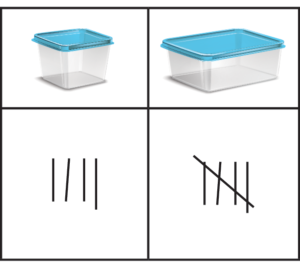
Take 1, 2, or 0
Have your child count 12 small objects (plastic eggs) onto a tray. Place two pennies in a cup. Take turns shaking and spilling the pennies. If both pennies land on “heads,” the shaker takes two eggs. If one penny lands on “heads,” the shaker takes one egg. If none of the pennies are heads, the shaker takes zero. When all eggs have been removed, count to see who has more.

Estimate How Many
Draw a large ten-frame on a piece of paper. Show your child a container filled with 11-15 plastic eggs or other small objects. Have her estimate how many eggs are inside the container. After estimating, have your child remove the eggs and place them in the ten-frame. Ask: Were there more than 10 eggs? How do you know? How many eggs were there?
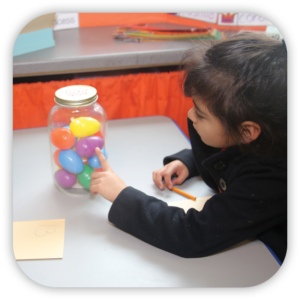
Humpty Dumpty
Act out this version of the rhyme “Humpty Dumpty.” Make a “wall” by holding both hands in front of your body with your palms facing your body and your fingertips touching. Have your child make a “bird egg” by wrapping one hand around the other fist. Have your child place her “egg” on the “wall.” Click image for rhyme.
Daily Message
Birds build a nest with twigs. A mother bird lays eggs in a nest.
- Say the sentences. Ask your child to repeat them.
- Say: lays rhymes with plays. Both words end with /ays/. Explain that you will say three words and your child will tell you the two words that rhyme. Say: bird, lays, plays—Which two words rhyme? Repeat with words: nest, rest, mother.
- Write the sentences.
Storytime
Show the cover of Gustavo. Ask: What do you think this story will be about? Point to the owl. Say: This is Gustavo. He is a barn owl. Barn owls like to nest inside barns. Read Gustavo. Ask: Why was Gustavo lonely? What did he do so he would not feel lonely? Have you ever felt lonely? When? What did you do?
Full to Empty
Fill five clear plastic cups with different amounts of colored water. Make one completely full and another empty. Show the cups in random order. Have your child move the cups so they are arranged from most to least full (empty). To do this, suggest your child arrange the cups so the water inside the cups looks like steps going down.
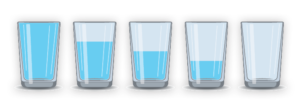
15 Ducks in a Row
Make a pile of 15 cotton balls. Have your child pretend the cotton balls are baby ducks. Ask: How many ducks do you think (estimate) there might be? Why do you think so? Suggest your child arrange the “ducks” in a straight line to make them easier to count. Have your child count them to confirm there are 15. Ask: Was your estimate close to 15?

Spot a Nest
Birds build nests in many places. Often nests are found in trees and bushes. Sometimes they are built inside barns or under rooftops of buildings. Some birds even build their nests on the ground. As you go through the week, see how many nests you can spot and write down where you find them.
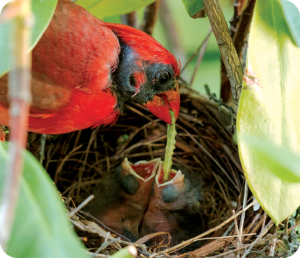
Two Little Blackbirds
Enjoy reciting the rhyme “Two Little Blackbirds” When prompted by the rhyme, change the speed (fast, slow) and pitch (high, low) of your voices. Ask: How would a flying hummingbird look different that a flying bald eagle? Replace the words “little blackbirds” with other bird names. Click image for rhyme.
Daily Message
A woodpecker has a long, strong bill.
- Say the sentence. Ask your child to repeat it.
- Say: long rhymes with strong. Both words end with /ong/. Explain that you will say three words and your child will tell you the two words that rhyme. Say: long, short, strong—Which two words rhyme? Repeat with words: digs, bill, hill.
- Write the sentence.
Writing Together
Write “birds” in the center of a piece of paper. Circle the word. Have your child suggest names of birds and bird characteristics. Write the ideas on the paper. You are creating a word web. Creating a web helps organize ideas. Point to each word and read it together.

Web-Footed Friends
Ducks have webbed feet. That means skin stretches between each of the toes. The webbed toes help ducks swim faster. Watch the music video “Be Kind to Your Web-Footed Friends.” Join Don Monopoli in flapping and marching with the music.
Storytime
Owls are nocturnal hunters. Remind your child that nocturnal means active during the night. Read Gustavo. Pages 8-9 show some owls hunting at night. Ask: What other animals do you know that are nocturnal? In this make-believe story, Gustavo finds a friend to stay in the barn with him. Ask: How do you think Gustavo felt about Salena’s gift?
The Same Area
Have your child arrange four squares of toilet paper or colored paper in the shape of a carpet for a long hallway. Challenge her to rearrange the same squares to form a square carpet for the floor of a bedroom. Point out that even though the shapes of the two carpet arrangements are different, they both use four squares. That means their area is the same.
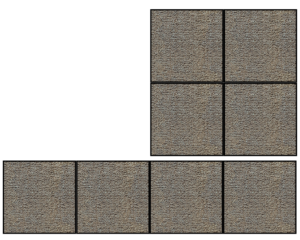
How Many Inside?
Draw a large ten-frame on paper. Show your child a storage case or plastic bag with 9 small objects (markers). Have her estimate how many objects are inside the case. After estimating, have your child remove the objects and place them in the ten-frame. Ask: Were there more than 10? How do you know? How many objects were there?

Rhyming Words
When you ride in the car or wait in line at the grocery store, practice rhyming words. Start with a simple word like cat. Change the beginning sound. For example, change the “c” to “m” and say mat. See how many words you can make. A nonsense word is fine (dat, gat).
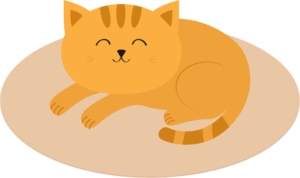
Bird Breathing
Work together with your child to create a bird breathing strategy. Ask: What are some ways a bird might move? What is a good move for taking a deep breath? What is a good move for exhaling slowly? Do your new strategy together.

Daily Message
Petie takes a journey. Wrens fly very fast.
- Say the sentences. Ask your child to repeat them.
- Say: very rhymes with berry. Both words end with /ery/. Explain that you will say three words and your child will tell you the two words that rhyme. Say: very, merry, moo—Which two words rhyme? Repeat with words: my, zoo, fly.
- Write the sentences.
My Journal
Show Birds. Read the title. Ask: What sound does the letter B make? Read the book with your child. Ask: Which bird is your favorite? Have your child draw her favorite bird on the first blank page of her journal. Help your child write the bird’s name.
Storytime
Read Petie’s First Flight. Remind your child that Petie is a wren. A wren is a little brown bird. It flies quickly. Sometimes it holds its tail straight up in the air. Wrens like to sing loudly. Have your child pretend to flap wings and sing a song like Petie might.
Can You Lift It?
Invite your child to lift objects around the house of varying weights. Emphasize safety, such as not straining his back or lifting things that could break. Sort the items by those he can lift above his head (beachball), above his feet (suitcase), and those he cannot lift at all (refrigerator). Ask: Does the size of the object matter? Why? Why not?
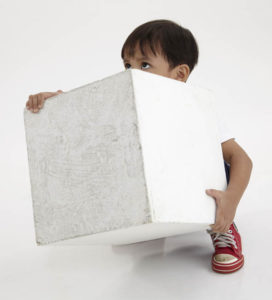
What Size Box?
Collect 12 same-sized stackable items, such as empty soda cans or bottles of water. Have your child count the items. Say: Imagine that these items need to be in a box for delivery. What size box would we need? Have your child arrange or stack items to visualize the perfect-sized box. Have him try packing the items inside boxes you have around the house.
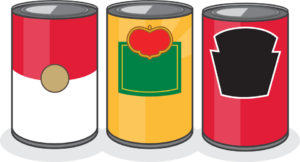
Compare Capacity
Remind your child that the capacity of a container is how much it holds. Give her the opportunity to compare the capacities of different containers. Your child will need several containers, water, and a safe spot for water exploration. Encourage your child to pour water from one container to another. Ask: How will you know which container holds the most water?
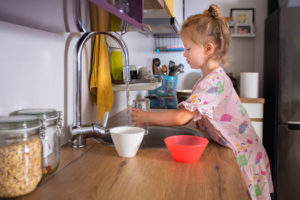
Reteach Commitments
Review commitments that would be helpful to reteach. When you reteach, keep the focus on modeling and describing what safe behavior looks like, sounds like, and feels like. You might want to role play situations with your child. Role play (show) what is not safe and then role play what is safe.
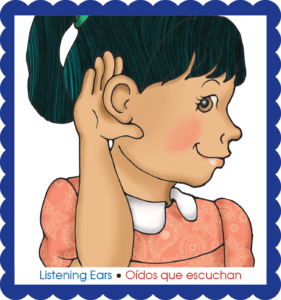
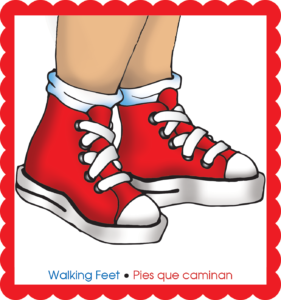
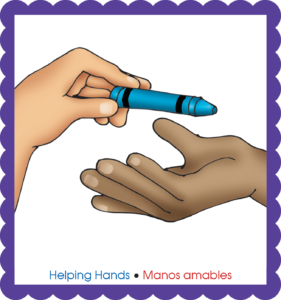
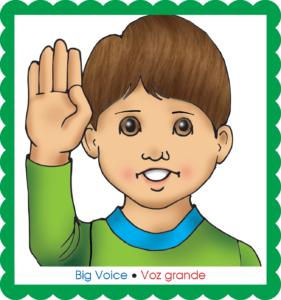
Daily Message
Each bird makes a unique sound. A mockingbird is not quiet.
- Say the sentences. Ask your child to repeat them.
- Say: not rhymes with hot. Both words end with /ot/. Explain that you will say three words and your child will tell you the two words that rhyme. Say: ball, hot, not—Which two words rhyme? Repeat with words: sound, round, fast.
- Write the sentences.
Match Letters
Focus: Dd, Gg, Ii,
Jj, Nn, Qq, Rr
Write the focus letters on index cards. Mix up the cards. Have your child line up matching pairs of uppercase and lowercase letters. Point to a letter pair, name the letter and say its sound. For example, point to D, d and say: D says /d/. Have your child do the same with a different letter. Take turns until all have been named.

Storytime
Watch the read-aloud video Petie’s First Flight. Pay particular attention to the photos and the captions that tell true facts. Ask: What did you learn about wrens? What did you learn about different kinds of birds? Which bird is your favorite? Why?
Is Ten the Same?
Find two grocery bags with handles. Put a different set of ten objects inside each bag. The objects should be different weights but a similar size. For example, have your child count ten cotton balls or plastic cups into one bag and ten marbles or spoons inside the other. Have your child lift the bags in opposite hands. Ask: Which bag is heavier? Are ten objects always the same weight? Why?
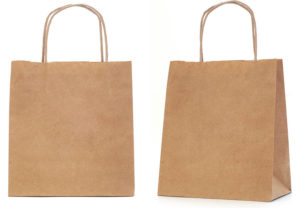
Hard-Boiled Egg
Before doing this activity, prepare a hard-boiled egg. When the egg is cool, have your child help you peel off the shell. Point out how the shell is hard, but fragile, which means it could easily break. Cut the egg in half, add a pinch of salt and serve as a snack.
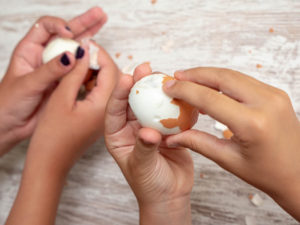
Bird Habitats
This week, you have learned that birds live in many places. Birds have special characteristics that help them survive in their homes. For example, ducks have webbed feet to help them paddle in the water. Name birds that live near water and those that do not. Click image to get started!



